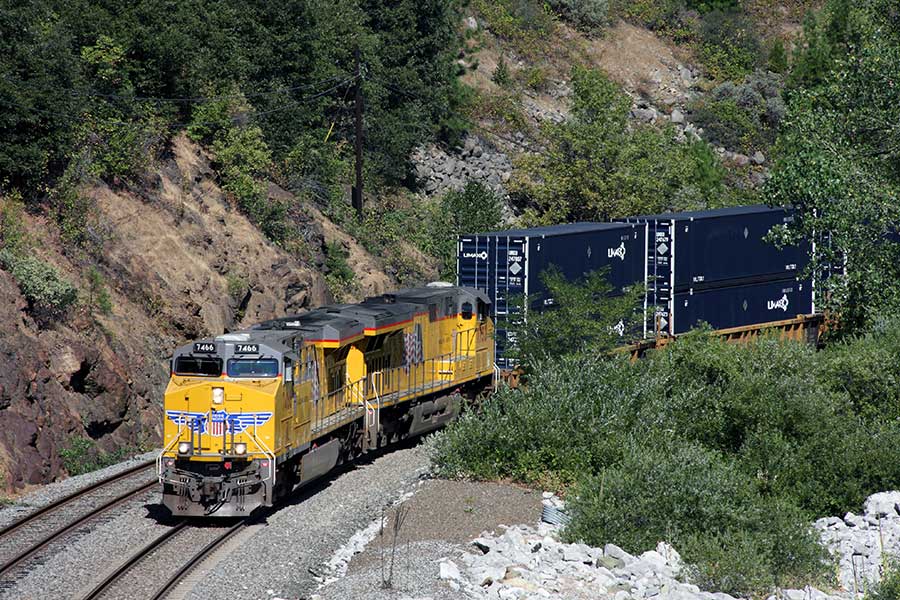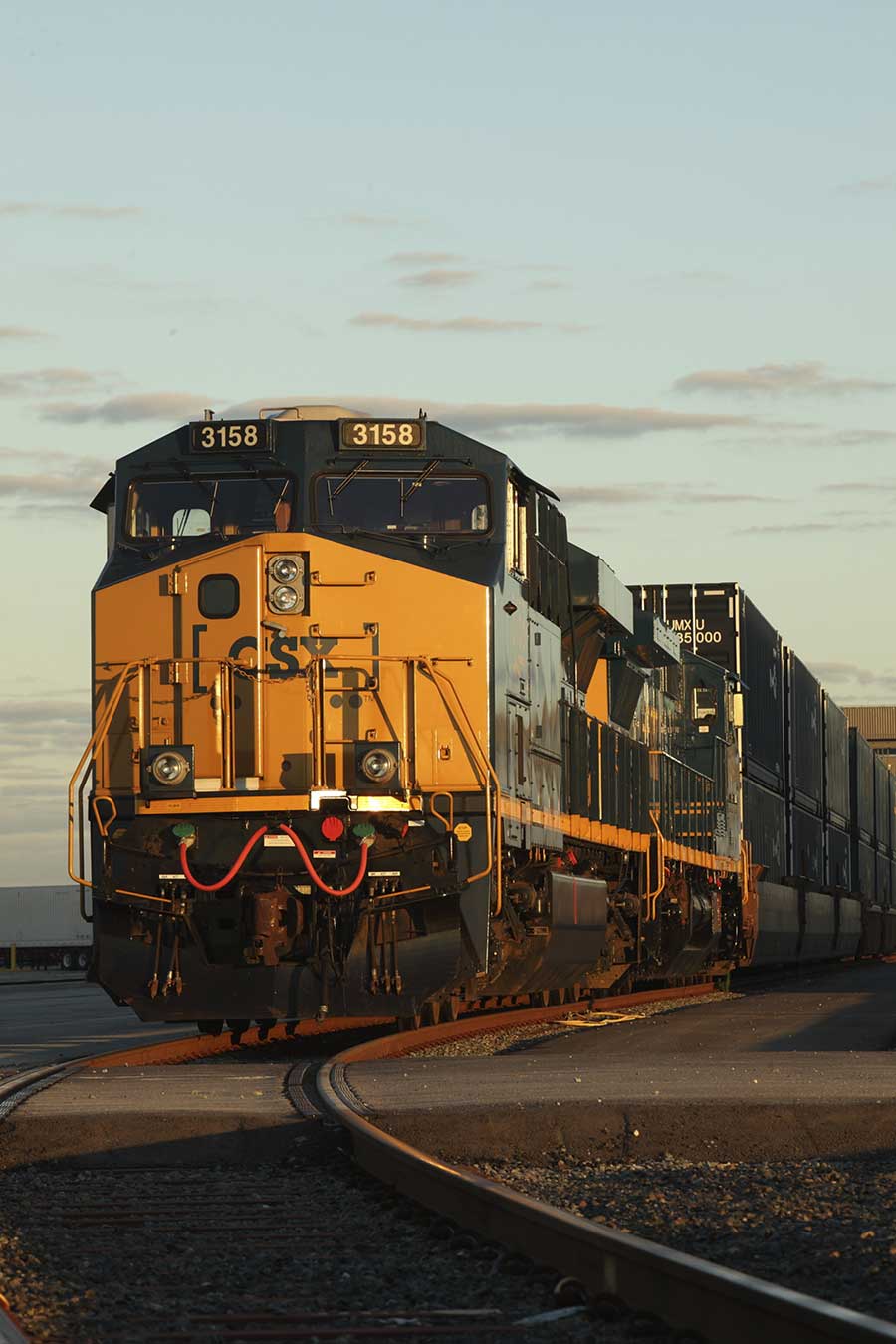By Jeff Stagl, Managing Editor
There were a number of trends and developments last year that didn’t bode well for the North American intermodal industry.
Retail inventories continued to normalize but were still outsized, meaning strong consumer spending didn’t translate into higher import and freight volumes; interest rate-sensitive markets were constrained — especially housing and manufacturing — because of U.S. Federal Reserve interest rate increases; and truckers responded to a shrinking freight market by reducing their rates to boost market share, which impacted rail.
Yet, intermodal stakeholders were able to cap off 2023 with a strong fourth quarter. Total North American intermodal volume in the quarter reached 4,367,940 units, up 3.1% year over year, according to the Intermodal Association of North America’s (IANA) Q4 market report.
Domestic container volume climbed 6% to 2,108,322 units; the international container count increased 2.9% to 2,090,804 units; and total domestic equipment volume rose 3.3% to 2,277,136 units.
In the domestic container sector, eight of IANA’s 10 regions registered gains compared with Q4 2022 levels. And the traffic segment’s prospects appear to be strong in 2024, IANA officials wrote in the report.
“Strong consumer spending and retail sales, along with an elevated number of unfilled orders for manufactured goods, should provide support for domestic container traffic and help partially offset weakness in the intermodal network going forward,” they said.
Eight of IANA’s 10 regions also posted international container volume growth in the quarter. Consumer spending on goods remained relatively stable throughout 2023, and wholesalers and retailers primarily were able to meet demand by tapping existing inventories and heavily discounting out-of-season inventory, IANA officials said.
“The divergence between the broader economy and the freight economy moderated in the fourth quarter, as bloated inventories and consumers’ preference for services over goods diminished,” they wrote.
The encouraging volume growth in Q4 was welcomed by intermodal constituents because the final 2023 traffic tallies would have been worse without them. Total North American volume in 2023 slipped 5.9% year over year to 16,669,980 units, with an 8.4% dive in international container traffic (to 7,916,550 units), a 3.5% drop in overall domestic equipment volume (to 8,753,430 units) and a 1.2% dip in the domestic container count (to 8,048,460 units).
 In the fourth quarter, Union Pacific Railroad’s intermodal volume rose 5%, but its intermodal revenue fell 5% compared with fourth-quarter 2022 figures. Port of Longview
In the fourth quarter, Union Pacific Railroad’s intermodal volume rose 5%, but its intermodal revenue fell 5% compared with fourth-quarter 2022 figures. Port of Longview UP: More loads, less revenue in Q4
For the Class Is, intermodal volume and revenue results were mixed in Q4. Union Pacific Railroad’s volume rose 5% to 782,000 units, driven by stronger West Coast imports, domestic business wins and strong traffic in Mexico. But its Q4 intermodal revenue fell 5% to $1.185 billion.
The Class I is off to a slower start in 2024 with both traffic and revenue because of severe winter storms and market challenges in both the intermodal and coal sectors. The economic environment continues to look muted in 2024, particularly in the first half, UP officials believe.
“On the international intermodal side, we expect the market to improve year over year, but a contract we lost earlier in 2023 will negatively impact our 2024 volumes,” UP leaders said Jan. 25 during the railroad’s Q4 earnings conference. “On the domestic side, we are staying close with our customers who have indicated that they'll see a soft start to the year. Nonetheless, our strong service product sets us up to handle market demand.”
CSX’s Q4 intermodal revenue declined 4% to $552 million on flat volume at 720,000 units. For all of 2023, revenue decreased 11% to $2.06 billion and volume fell 7% to 2.76 million units compared with 2022 figures.
“Our domestic intermodal business continued to perform well, with volume increasing sequentially and growing in the mid-single digits on a year-over-year basis,” CSX officials said Jan. 24 during the Class I’s earnings conference. “Our ability to deliver domestic growth was an extraordinary team effort, especially given the significant challenges facing the trucking market.”
In terms of international intermodal business, volume was lower in the quarter, but traffic improved each month. Volume in December showed a modest year-over-year increase as the positive effects of more normalized retailer inventories gain traction, CSX officials said.
“Our team has continued to work hard to maximize our opportunities, which showed up in the growth as we work to build new partnerships, create new service offerings and leverage higher activity at the inland ports that we serve,” they said. “Positive market trends are taking shape, and we expect the combination of a more supportive market, new conversion opportunities and service offerings to drive year-over-year growth in both the domestic and the international business this year.”
 Lingering uncertainty about how quickly truck capacity right-sizes and the effects of stronger consumer spending in a softer economy could impede intermodal growth, NS says. Norfolk Southern Railway
Lingering uncertainty about how quickly truck capacity right-sizes and the effects of stronger consumer spending in a softer economy could impede intermodal growth, NS says. Norfolk Southern Railway NS: Ready to pounce pending truck capacity
For Norfolk Southern Railway, Q4 intermodal volume rose 5% year over year to 1 million units driven by strong domestic and international business. But intermodal revenue fell 13% to $794 million, in part because of an excess supply of available trucks and a negative mix within the international business.
“We're confident our domestic franchise is a coiled spring, positioned to yield strong incremental value as the truck market recovers,” NS officials said Jan. 26 during the Class I’s earnings conference. “We are optimistic that increasing levels of international trade will boost demand for both our domestic and international services.”
However, there's still uncertainty about how quickly truck capacity right-sizes, and consumer spending strength could pressure growth if the economy softens, they added.
In the nation to the north, Canadian Pacific Kansas City’s intermodal revenue tumbled 11% while volume was flat. Domestic intermodal continues to be challenged by lower retail volumes, ample truck capacity and some general market softness, CPKC officials said during a Jan. 30 earnings conference.
But international intermodal business rebounded in Q4 as inventory was cleared following the fall strike at the Port of Vancouver and container volume reached strong levels at the Port of Lazaro Cardenas in Mexico, they said. The port’s container volume jumped 30% and CPKC’s volume associated with Lazaro Cardenas grew 35% versus 2022 figures.
Domestic performance should improve in 2024 as the truck-like Mexico Midwest Express intermodal service presents opportunities for synergy gains from over-the-road conversions, CPKC officials said. Launched in May 2023, the service offers the only dedicated intermodal trains operating daily between the U.S. Midwest and Mexico.
In addition, a new Americold facility is scheduled to break ground in March in Kansas City, Missouri. Anchored by CPKC’s service, Americold is planning facilities that combine cold storage and value-added-services with expedited intermodal transportation solutions to connect key U.S. Midwest and Mexico markets.
 Since market conditions are trending in a positive direction, CSX expects growth in both domestic and international intermodal business this year. CSX
Since market conditions are trending in a positive direction, CSX expects growth in both domestic and international intermodal business this year. CSX CN: Sequential volume uptick is uplifting
Meanwhile, CN’s intermodal volume tumbled 15% to 1.8 million carloads and revenue plummeted 20% to CA$948 million compared with Q4 2022 totals. International business was hampered by lingering effects of the port strike, particularly for Port of Prince Rupert traffic. But imports at both West Coast ports returned to pre-strike levels by December.
“We continue to work on filling up Prince Rupert and building on recent momentum in Vancouver. We also expect growth in our southern ports in the Gulf, driven by new service offerings into the Midwest,” CN officials said Jan. 23 during an earnings conference. “We are encouraged by the sequential uptick in volumes in the fourth quarter and with our ongoing discussions with steamship line customers.”
Domestic business dropped 3%, but CN officials expect a gradual return to pre-COVID volume levels over the next few quarters.
“Domestic growth will come from our new interline partnerships specifically targeting truck volumes. We have capacity on the network, in our terminals and with our fleet to grow volumes as the economy improves,” they said.
Overall, the outlook for freight moving by rail versus trucks is better than it has been for a couple of years, even if intermodal continues to suffer from weak truckload-driven pricing, IANA officials wrote in the quarterly report. U.S. economic activity remains strong and the possibility of a soft economic landing appears more likely in early 2024.
“While freight-related components of the economy have underperformed over the past two years, it appears that downward trend has come to an end,” IANA officials wrote. “Imports of goods have started to pick back up against a backdrop of a strong retail environment where sales remain consistent, bloated inventories have been worked down and they are now approaching or are consistent with pre-pandemic levels, depending on the sector.”
Trucking has placed intermodal at a competitive disadvantage, and any improvement over the course of 2024 and into 2025 probably will be incremental, they believe.
“Although spot rates in trucking have bottomed out, that is a double-edged sword — stronger rates will likely slow the exit of financially stressed small trucking firms from the market, especially if diesel prices continue their downward slide,” IANA officials wrote.



